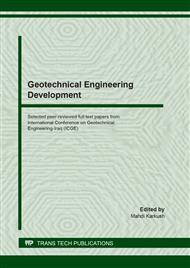[1]
B.B.K. Huat. Deformation and Shear Strength Characteristics of Some Tropical Peat and Organic Soils. Pertanika J. Sci. & Techno. 14(2006) 61–74.
Google Scholar
[2]
B.G. Mamo, K.K. Banoth, A. Dey. Effect of strain rate on shear strength parameter of sand. 50th Indian geotechnical conference 17th – 19th December, pune, maharashtra, India venue: college of engineering (estd. 1854), pune, India (2005).
Google Scholar
[3]
J.L.J. Lemos. Shear behavior of pre-existing shear zone under fast loading-insights on the landslide motion. Proc. International workshop on occurrence and mechanisms of flow-like landslide motion, (2003), p.229–236.
Google Scholar
[4]
A.W. Skempton. Residual strength of clays in landslides, folded strata and the laboratory. G´eotechnique. 35(1985), 3–18.
DOI: 10.1680/geot.1985.35.1.3
Google Scholar
[5]
T.E. Tika, P.R. Vaughan, J.L.J. Lemos. Fast shearing of pre-existing shear zone in soil. G´eotechnique. 46, No. 2, 97–233 (1996).
DOI: 10.1680/geot.1996.46.2.197
Google Scholar
[6]
A. Casagrande. W.L. Shannon, Strength of soils under dynamic loads. Proceedings of the Second International Conference on Soil Mechanics and Foundation Engineering. 74(4), 591–608, (1948).
Google Scholar
[7]
J.A. Yamamuro, P.V. Lade. Effects of strain rate on instability of granular materials. Geotechnical Testing Journal. 16(3), 304-313, (1993).
DOI: 10.1520/gtj10051j
Google Scholar
[8]
T. Matsui, H. Ohara, T. Ito. Effects of dynamıc stress hıstory on mechanıcal characterıstıcs saturated clays. Journals of the Japan Society of Civil Engineers. 257, p.41–51. (in Japanese), (1977).
DOI: 10.2208/jscej1969.1977.41
Google Scholar
[9]
Y. Matsuoshi, Y. Matsukura. Cohesion of Unsaturated Residual Soils as a Function of Volumetric Water Content. Bull. Eng. Geol. Environ. Vol. 65, No. 4, 449–455, (2006).
DOI: 10.1007/s10064-005-0035-9
Google Scholar
[10]
S.Y. Oloo, D.G. Fredlund. A Method for Determination of Øb for Statically Compacted Soils. Canadian Geotechnical Journal. Vol. 33, p.272–280, (1996).
DOI: 10.1139/t96-006
Google Scholar
[11]
C.C. Fan, C.F. Su. Role of roots in the shear strength of root-reinforced soils with high moisture content. Ecol. Eng. 33, 157–166, (2008).
DOI: 10.1016/j.ecoleng.2008.02.013
Google Scholar
[12]
M. A. Dafalla, M. A. Al-Shamrani, A. Obaid. Reducing erosion along the surface of sloping clay-sand liners. Proceedings of the ASCE Geo-Congress, San Diego. Calif, USA, (2013).
DOI: 10.1061/9780784412787.185
Google Scholar
[13]
N. O. Abdulhadi, J.T. Germaine, A.J. Whittle. Stress-dependent behavior of saturated clay. Can.Geotech. J. 40: 907-916, (2012).
DOI: 10.1139/t2012-057
Google Scholar
[14]
C.C. Ladd, R. Foot. New design procedure for stability of soft clays. Journal of Geotechnical engineering Division, 100,7, 763-786, (1974).
DOI: 10.1061/ajgeb6.0000066
Google Scholar
[15]
O. Nasir, M. Fall. Shear behaviour of cemented pastefill-rock interfaces. Engineering Geology. 101, 146–153, (2008).
DOI: 10.1016/j.enggeo.2008.04.010
Google Scholar
[16]
J.G. Potyondy. Skin friction between various soils and construction materials, Geotechnique. 11(4), 339–353, (1961).
DOI: 10.1680/geot.1961.11.4.339
Google Scholar
[17]
ASTM International, D2974. Standard Test Methods for Moisture, Ash, and Organic Matter of Peat and Other Organic Soils, (2014).
DOI: 10.1520/d2974-14
Google Scholar
[18]
ASTM D1997. Standard Test Method for Laboratory Determination of the Fiber Content of Peat Samples by Dry Mass, ASTM International, West Conshohocken, PA, USA, (2013).
Google Scholar
[19]
ASTM D2974. Standard test methods for moisture, ash, and organic matter of peat and other organic soils. ASTM International, West Conshohocken, PA, USA, (2014).
DOI: 10.1520/d2974-14
Google Scholar
[20]
ASTM D2976. Standard Test Method for pH of Peat Materials, ASTM International, West Conshohocken, PA, USA, (2015).
Google Scholar
[21]
ASTM International, D3080. Direct Shear Test of Soils Under Consolidated Drained Conditions, (2011).
Google Scholar
[22]
A.I. Al-Mhaidib. Shearing Rate Effect on Interfacial Friction Between Sand and Steel. The Fifteenth International Offshore and Polar Engineering Conference. 8, 633-640, (2005).
Google Scholar
[23]
K. Anim. Effect of Strain Rate on the Shear Strength of Questa Rock Pile. Ph.D. thesis, New Mexico Institute of Mining and Technology Department of Mineral Engineering, (2010).
Google Scholar
[24]
Y. Yoshida, J. Kuwano, R. Kuwano. Effect of Saturation on the Shear Strength of Soils. Japanese Society of Soil Mechanics and Foundations Engineering, Vol. 31, pp.181-186, (1991).
DOI: 10.3208/sandf1972.31.181
Google Scholar
[25]
E. Cokca, O. Erol, F. Armangil. Effects of compaction moisture content on the shear strength of an unsaturated clay. Geotechnical and Geological Engineering. 22: 285–297, (2004).
DOI: 10.1023/b:gege.0000018349.40866.3e
Google Scholar
[26]
H.B. Seed, J.K. Mitchell, C.K. Chan. The strength of compacted cohesive soils in Shear Strength of Cohesive Soils, ASCE, Boulder, CO. p.877–964, (1961).
Google Scholar
[27]
G.B. Baecher, J.T. Christian. Reliability and Statistics in Geotechnical Engineering. John Wiley and Sons, London and New York, (2003).
Google Scholar
[28]
L. Lemos. The effect of rate of shear on the residual strength of soil. PhD Thesis. Imperial College. University of London, (1986).
Google Scholar
[29]
H. Canakci, M. Hamed, F. Celik, W. Sidik, F. Eviz. Friction characteristics of organic soil with construction materials. Soils and Foundations, 56, 6, pp.965-972, (2016).
DOI: 10.1016/j.sandf.2016.11.002
Google Scholar
[30]
A.J. Koolen, H. Kuipers. Agricultural Soil mechanics. Springer-Verlag. New York. pp.171-280, (1983).
Google Scholar


